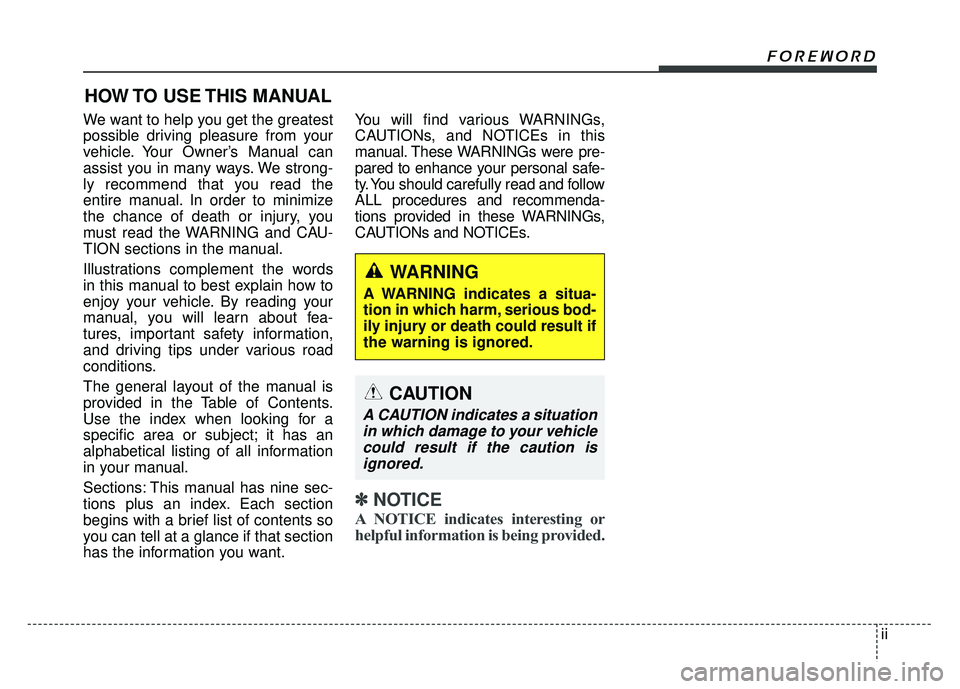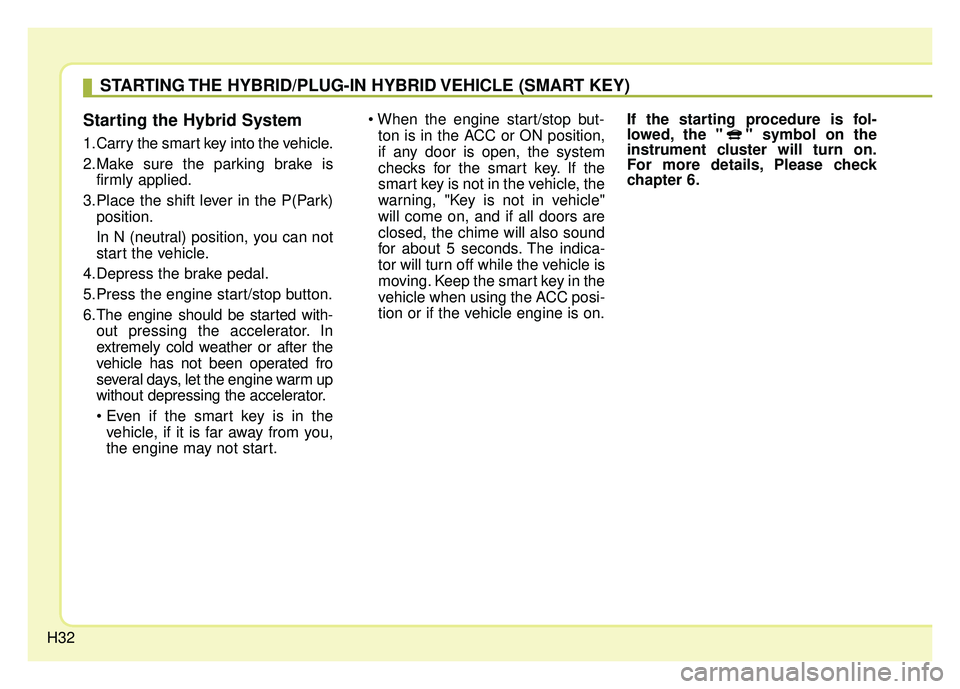warning KIA OPTIMA PHEV 2018 Owners Manual
[x] Cancel search | Manufacturer: KIA, Model Year: 2018, Model line: OPTIMA PHEV, Model: KIA OPTIMA PHEV 2018Pages: 547, PDF Size: 11.56 MB
Page 4 of 547

ii
Foreword
We want to help you get the greatest
possible driving pleasure from your
vehicle. Your Owner’s Manual can
assist you in many ways. We strong-
ly recommend that you read the
entire manual. In order to minimize
the chance of death or injury, you
must read the WARNING and CAU-
TION sections in the manual.
Illustrations complement the words
in this manual to best explain how to
enjoy your vehicle. By reading your
manual, you will learn about fea-
tures, important safety information,
and driving tips under various road
conditions.
The general layout of the manual is
provided in the Table of Contents.
Use the index when looking for a
specific area or subject; it has an
alphabetical listing of all information
in your manual.
Sections: This manual has nine sec-
tions plus an index. Each section
begins with a brief list of contents so
you can tell at a glance if that section
has the information you want.You will find various WARNINGs,
CAUTIONs, and NOTICEs in this
manual. These WARNINGs were pre-
pared to enhance your personal safe-
ty. You should carefully read and follow
ALL procedures and recommenda-
tions provided in these WARNINGs,
CAUTIONs and NOTICEs.
✽ ✽
NOTICE
A NOTICE indicates interesting or
helpful information is being provided.
HOW TO USE THIS MANUAL
WARNING
A WARNING indicates a situa-
tion in which harm, serious bod-
ily injury or death could result if
the warning is ignored.
CAUTION
A CAUTION indicates a situation
in which damage to your vehiclecould result if the caution isignored.
Page 12 of 547

H6 When scheduled charging is set
and the normal charger or the
portable charging cable (ICCB: In-
Cable Control Box) is connected
for charging, the indicator lamp
blinks (for 3 minutes) to indicate
that scheduled charging is set. When scheduled charging is set,
charging is not initiated immediate-
ly when the normal charger or
portable charging cable (ICCB: In-
Cable Control Box) is connected.
When immediate charging is
required, use the AVN to deacti-
vate the scheduled charge setting.
Charging Precautions
CHARGING THE PLUG-IN HYBRID VEHICLE (CONT.)
OJFHPQ016009L
OJFHPQ016021L
■ Normal Charger
WARNING
- Fires caused by dust or
water
Do not connect the charging
cable connector plug to the
vehicle if there is water or dust
on the charging inlet.
Connecting while there is water
or dust on the charging cable
connector and plug may cause
a fire or electric shock.
Page 13 of 547

H7
Comply with the following in orderto prevent electrical shock when
charging:
- Use a waterproof charger
- Make sure to not touch the charg-ing connector and charging plug
when your hand is wet
- Do not charge when there is light- ning
- Do not charge when the charging connector and plug is wet
WARNING
-
Interference with electron-
ic medical devices
When using medical electric
devices such as an implantable
cardiac pacemaker, make sure to
ask the medical team and manu-
facturer whether charging your
electric vehicle will impact the
operation of the medical
devices. In some instances, elec-
tromagnetic waves that are gen-
erated from the charger can seri-
ously impact medical electric
devices such as an implantable
cardiac pacemaker.
WARNING
-
Touching the charging
connector
Do not touch the charging con-
nector, charging plug, and the
charging inlet when connecting
the cable to the charger and the
charging inlet on the vehicle.
Doing so may result in electro-
cution.
WARNING
-
Public Electric Outlets
Do not use old or worn out pub-
lic electric outlets to charge
your vehicle. There may be a
risk of fire and injury when
using old worn out public elec-
trical outlets.
Page 14 of 547

H8 Always keep the charging connec-
tor and charging plug in clean and
dry condition. Be sure to keep the
charging cable in a condition where
there is no water or moisture.
Make sure to use the designated charger for charging the vehicle.
Using any other charger may
cause failure.
Before charging the battery, turn the vehicle OFF.
Be careful not to drop the charging connector. The charging connector
can be damaged.
CHARGING THE PLUG-IN HYBRID VEHICLE (CONT.)
WARNING - Charging
cable
• Immediately stop charging when you find abnormal
symptoms (smell, smoke).
Replace the charging cable if the cable coating is damaged
to prevent electrical shock.
When connecting or removing the charging cable, make sure
to hold the charging connec-
tor handle and charging plug.
If you pull the cable itself
(without using the handle), the
internal wires may disconnect
or get damaged. This may lead
to electric shock or fire.WARNING - Cooling fan
Do not touch the cooling fan
while vehicle is charging. When
the vehicle is switched OFF
while charging, the cooling fan
inside the motor compartment
may automatically operate.
Page 19 of 547

H13
3. Make sure to securely close thecharging door.
✽
✽NOTICE
• Keep the charging connector and
the charging plug clean and dry.
The charging cable should be also
kept dry.
• Use an air gun to blow any foreign substances from the charging con-
nector and the charging plug.
Trickle Charger
Trickle charger can be used if
Normal Charger is unavailable.
❈➀ : Charging connector
➁ : Charging cable
➂ : Control box
\b : Cord and plug (cord set)
OJFHPQ016014N
OJFHPQ016013
WARNING
Do not modify or disassemble
the charging cable compo-
nents. Doing so may cause a
fire or an electric shock result-
ing in personal injuries.
Page 26 of 547

H20
Precautions for PortableCharging Cable (ICCB: In-Cable Control Box)
Use the portable charging cable that is certified by Kia.
Do not try to repair, disassemble, or adjust the portable charging cable.
Do not use an extension cord or adapter.
Stop using immediately if failure warning light occurs.
Do not touch the plug and charging connector with wet hands.
Do not touch the terminal part of the normal charging connector and the
normal charging inlet on the vehicle.
Do not connect the charging con- nector to voltage that does not
comply with regulations.
Do not use the portable charging cable if it is worn out, exposed, or
there exists any type of damage on
the portable charging cable. If the ICCB case and normal
charging connector is damaged,
cracked, or the wires are exposed
in any way, do not use the portable
charging cable.
Do not let children operate or touch the portable charging cable.
Keep the control box free of water.
Keep the normal charging connec- tor or plug terminal free of foreign
substances.
Do not step on the cable or cord. Do not pull the cable or cord and
do not twist or bend it.
Do not charge when there is light- ning.
Do not drop the control box or place a heavy object on the control
box.
Do not place an object that can generate high temperatures near
the charger when charging. Charging with the worn out or dam-
aged household electric outlet can
result in a risk of electric shock. If
you are in doubt to the household
electric outlet condition, have it
checked by a licensed electrician.
Stop using the portable charging cable immediately if the household
electric outlet or any components
is overheated or you notice burnt
odors.
CHARGING THE PLUG-IN HYBRID VEHICLE (CONT.)
Page 28 of 547

H22
Warning and indicator lights
Ready Indicator
This indicator illuminates :
When the vehicle is ready to be driven.
- ON : Normal driving is possible.
- OFF : Normal driving is not possible,
or a problem has occurred.
- Blinking : Emergency driving.
When the ready indicator goes OFF
or blinks, there is a problem with the
system. In this case, we recommend
that you have your vehicle inspected
by an authorized Kia dealer.
Hybrid system warning light
This warning light illuminates:
When there is a malfunction with the
hybrid system.
In this case, we recommend that you
have the vehicle inspected by an
authorized Kia dealer.
When the warning light illuminates
while driving, or does not go OFF
after starting the vehicle, have your
vehicle inspected by an authorized
Kia dealer.
EV Mode Indicator
This indicator illuminates when the
vehicle is driven by the electric motor.
Charging CableConnection Indicator(Plug-in hybrid)
This indicator illuminates in red when
the charging cable is connected.
DRIVING THE HYBRID/PLUG-IN HYBRID VEHICLE (CONT.)
EV
Page 38 of 547

H32
Starting the Hybrid System
1.Carry the smart key into the vehicle.
2.Make sure the parking brake isfirmly applied.
3.Place the shift lever in the P(Park) position.
In N (neutral) position, you can not
start the vehicle.
4.Depress the brake pedal.
5.Press the engine start/stop button.
6.The engine should be started with- out pressing the accelerator. In
extremely cold weather or after the
vehicle has not been operated fro
several days, let the engine warm up
without depressing the accelerator.
vehicle, if it is far away from you,
the engine may not start.
ton is in the ACC or ON position,
if any door is open, the system
checks for the smart key. If the
smart key is not in the vehicle, the
warning, "Key is not in vehicle"
will come on, and if all doors are
closed, the chime will also sound
for about 5 seconds. The indica-
tor will turn off while the vehicle is
moving. Keep the smart key in the
vehicle when using the ACC posi-
tion or if the vehicle engine is on. If the starting procedure is fol-
lowed, the " " symbol on the
instrument cluster will turn on.
For more details, Please check
chapter 6.
STARTING THE HYBRID/PLUG-IN HYBRID VEHICLE (SMART KEY)
Page 41 of 547

H35
The Hybrid battery uses high voltage
top operate the electric motor and
other components and other compo-
nents. High voltage is dangerous if
touched.
Your vehicle is equipped with orange
colored insulation and covers over
the high voltage components to pro-
tect people from electric shock. High
voltage warning labels are attached
to some system components as
additional warnings. Your vehicle is
recommended to be serviced by an
authorized Kia dealer.
WARNING - High voltage
components
Never touch orange or high volt-
age labeled components includ-
ing wires, cables, and connec-
tions. If the insulators or covers
are damaged or removed, severe
injury or death from electrocu-
tion may occur.
WARNING- Touching HPCU
When replacing the fuses in the
engine compartment, never
touch the HPCU. The HPCU car-
ries high voltage. Touching the
HPCU could result in electrocu-
tion, serious injury, or death.
OJFHQ015002
OJFHQ015003
HPCU
HEV Battery
Page 42 of 547

H36
✽
✽NOTICE - Prolonged parking
Prolonged parking might cause bat-
tery discharge and operation failure
due to natural discharge. Driving
the vehicle approximately once
every 2 months, more than 9 mile
(15 km) is recommended. The bat-
tery will be charged automatically
when driving the vehicle.
CAUTION- High Voltage
Battery Damage
When loading your vehicle, be careful of transporting items in amanner that could damage thehigh voltage battery. Do notstore items on top of the highvoltage battery or overload thetrunk area. Such actions mayultimately damage the high volt-age battery unit.
CAUTION- Carrying
Liquids in Trunk
Do not load large amounts of liq- uid in open containers in the vehi-cle. If spilled onto the HEV bat-tery, the liquid may cause a shortor further damage to the battery.
COMPONENTS OF THE HYBRID/PLUG-IN HYBRID VEHICLE(CONT.)
WARNING- Battery
Electrolyte
As with all batteries, avoid fluid
contact with the Hybrid battery.
If the battery is damaged and if
electrolyte comes in contact
with your body, clothes or eyes,
immediately flush with a large
quantity of fresh water.
OYFH021002N
Motor
WARNING- After-market
Battery Charger
Do not use an after-market bat-
tery charger to charge the
Hybrid battery. Doing so may
result in death or serious injury.